Basic Coffee knowledge Picture Coffee roasting process Wizard
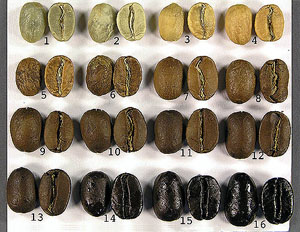
Naked eye observation as one of the methods to determine the roasting degree of coffee beans is very limited when used alone. If it is supplemented by the judgment of burst sound and the discrimination of fragrance, quite accurate results can be obtained. But the world of coffee is full of surprises and rarely conventional, and explosive Sumatra is often mistaken for urban baking. Some coffee beans appear darker than they are roasted, such as Kenya and St. Helena (including some sun-tanned Brazil). Natural sun-treated beans often have some color differences when baking, so it is difficult to determine the baking degree by naked eye observation. But this has nothing to do with the quality of coffee: the quality of coffee depends on its performance in the cup.
When it comes to quality, there are various definitions of optimal baking. Some ads advertise "deep baking" or "slow baking". In fact, depending on the type of baking equipment, it doesn't make any sense. more often it's just pale nonsense (who's ever heard of shallow baking?). I agree that the ideal optimal roasting should maximize the characteristics of the coffee itself, that is, to maximize the characteristics of the origin of the coffee. This is often associated with urban baking, although in appearance, urban baking is slightly inferior to deep urban baking, which is more balanced in color and fully expanded. But as we said above, a cup of coffee is judged by the quality in the cup rather than the beautiful appearance, whether it's raw beans or roasted. The "baking characteristics" produced by deep-roasted coffee tend to mask the "origin characteristics" of coffee when the coffee is roasted into a specific style, but its original native flavor takes second place. In some of the baking between French and "carbon", the original qualities of coffee are almost gone.
These coffees are baked in my Probat 12KG roaster. Thanks to the sample stick design of the machine, I can extract and save samples from any batch of beans at any time. Based on the difference of temperature detection methods, the baking temperature given below will be different from other roasters. Please ignore the baking time and use the temperature as a reference for the floating range. All we want to show is the color, appearance and surface texture of coffee beans during the corresponding roasting process.
1. Raw beans 0:00-75 f [23 degrees Celsius]
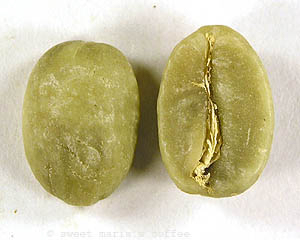
This is a batch of organic coffee that was accidentally mixed a few months ago, but unfortunately, due to the loss of the specific formula, it is difficult for us to deal with it. Although there is no shortage of good beans. I hope to find a suitable charity for this batch of beans. In short, the following photos are taken from these beans, so there may be a big difference between beans and beans. Just from the outside, it doesn't look like a typical Highland coffee, and I suspect there may be some KONA mixed with it.
two。 Start whitening 4:00-270F [132C]
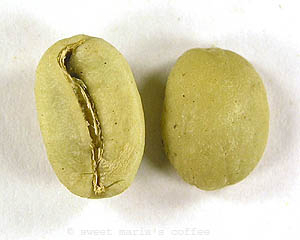
The beans selected at random may be typical of Kenna, and further, it may be the traditional Bourbon variety or Mundo Novo. As you can see, I am not waiting for a sample (there is no reason to do so). Instead, we select the stage to extract the sample which shows obvious visual difference. For large and medium-sized drum roasters, it takes a long time to transfer heat. So there was no significant difference in the first few minutes. At the same time, once again, I do not pursue the best baking effect in this batch of baking, but just bake it brown for shooting.
3. Early yellowing 6:00-327f [164C]
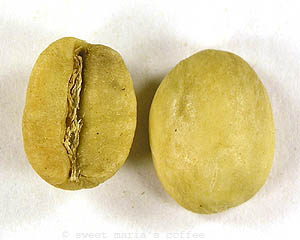
At this time, the coffee is still losing moisture in the form of evaporation without physical expansion. The hot air roaster can reach this stage earlier. Because the hot air can effectively exchange heat and take away the steam. The coffee at this time has a moist grass flavor. All the warm-up stages before an explosion are endothermic reactions, and coffee beans absorb heat from the environment, accumulating energy for the upcoming audible baking reaction.
4. Brown stage 6:30-345F [174C]

At this time, the coffee beans began to appear brown. Marbling appears on the surface, but it still does not expand. You can smell the slightly damp smell of roasted wheat. Some varieties of colors will appear brighter at this stage. Such as Costa Rica and Mexico.
5 light brown stage 8:00-370F [188C]
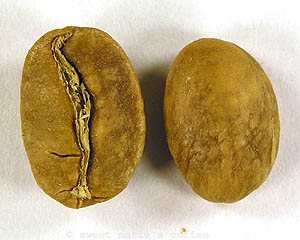
At this time, as the explosion approached, some beans swelled slightly and the midline opened. So that the silver skin attached to the midline begins to fall off.
6. Brown stage 9:00-393f [200C]
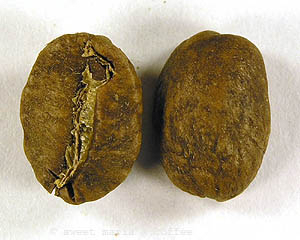
Now we have arrived at the door of the explosion. Coffee beans turn brown rapidly in a short period of time, which is partly due to the caramel reaction, but more importantly, the "Medra reaction" (which is also why the steak turns red)
7. The first explosion starts at 9:20-401f [205C]
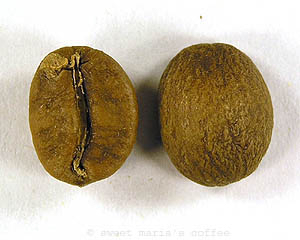
At this time, we can hear sporadic popcorn-like popping sound, which is obviously different from the dense and intense second popping sound. Again, the temperature indication is only that there is a big difference between the ambient temperature and the actual temperature in the coffee bean, and the temperature in the bean is 356 degrees Fahrenheit measured by a more complex method.
8. An explosion is in progress at 10:00-415F [213C]
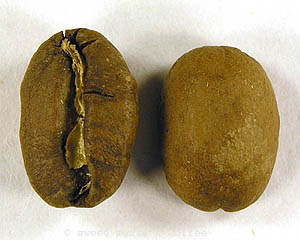
When an explosion is in progress, the surface color of the coffee still appears mottled and uneven. The burst of the bean body leads to the expansion of the coffee bean, the steam escapes from the inside of the bean, and the midline is fully opened, so that the remaining silver skin falls off completely. Because an explosion is an exothermic reaction, it will cause the beans to cool down. But it soon turns into an endothermic reaction, which means that if the roaster fails to supply heat in time, baking will stagnate at this point. This is not a good thing, once the caramel reaction begins (340 degrees Fahrenheit), the loss of temperature will produce a bitter "roasting" taste, which may be caused by the interruption of the long-chain polymerization. The melting point of sucrose is 370 degrees Fahrenheit, which is exactly the same as the coking reaction temperature indicated here.
9. The end of one explosion is 10:40-426f [219C]

This stage is called urban baking, and the surface of swollen beans becomes smoother. But there are still dark marks like fine depictions. Here, the escape of water vapor and carbon dioxide is the main cause of soybean expansion.
10. City Baking + 11:05 435F [224C]

The stage between the first explosion and the second explosion is a short endothermic period. when the temperature reaches a certain temperature, the wood fiber matrix structure of the coffee bean itself begins to break, and the second explosion begins. It can be observed that the color darkens rapidly in a very short period of time, while the temperature change is not obvious compared with the previous stage.
11. Deep city baking 11:30-444f is on the verge of a second explosion [229C]
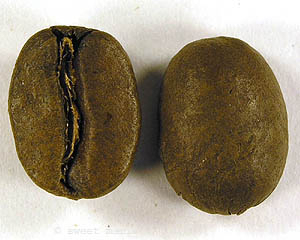
The picture shows the lighter depth of city baking. At this time, the coffee is on the edge of a second explosion. The temperature inside the second explosion is usually about 446 degrees Fahrenheit. In fact, the second explosion is more difficult to predict than the first explosion. Why? In my experience, this is because the first explosion is caused by the escape of water vapor and carbon dioxide, which leads to the physical expansion of the bean, while the second explosion is the process of physical fracture of the fiber structure. The size and density of coffee are different in different producing areas, different varieties and different elevations. It is conceivable that their fiber structures are also different, and orderly wood fibers are more likely to react than disordered wood fibers.
twelve。 Deep city baking + 11:50-454f second explosion begins [234.5 degrees Celsius]

The picture shows heavy roasting in the deep city, when the coffee beans have almost entered the second explosion. The baking ends 10 seconds after hearing the second explosion, and we can easily see a more significant difference by comparing it with the full picture of baking in the deep city. But a more reliable way is to judge by sound.
13. Vienna-shallow French baking 12:15-465f second explosion in progress [240.5 degrees Celsius]
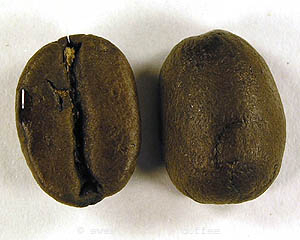
Vienna (European)-shallow French roasting is the beginning when the original characteristics of coffee are overshadowed by roasting characteristics, and if you are buying coffee for different flavors, heavy roasting may not be suitable for you. There are exceptions, however, and some coffees may perform quite well at this stage.
It should be noted that Espresso is not a kind of baking, but the northern Italian style espresso is often baked to an internal temperature of 440-446 degrees, while southern Italian is generally equivalent to shallow French baking or deeper.
14. Deep French baking 12:40-474f second explosion is nearing the end [245.6 degrees Celsius]
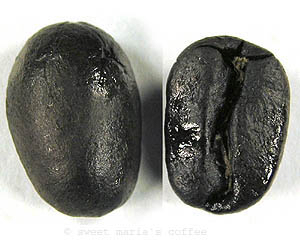
The sugar is highly caramelized (it looks as if it was charred) and decomposed at the same time. The wood structure in the bean begins to carbonize, and the volume continues to grow, but the weight becomes lighter and lighter. The aromatic compounds, oils and soluble substances in beans begin to burn and become the smoke that fills your room. 474 degrees is far more than all the normal baking I use Probat. My limit is 465 degrees Fahrenheit
15. Full carbonization 13:00-486F [252C]

Some people call it Italian or Spanish, insulting these two baking modes. At this stage, more than 25% of the coffee beans have been reduced to ashes. The rest are carbonized, dead, charred beans.
16. Internal combustion 13:30-497f [258C]
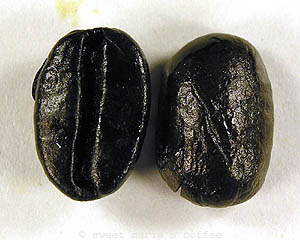
At this time, the beans are on the edge of burning. in fact, if the amount of baking is large enough, an adequate supply of oxygen will cause the flame to ignite at the moment of the beans. If it is a 2-to 3-bag large roaster, please contact your local fire department before trying 497 degrees. Needless to say, the beans have become very small at this time, and there is no obvious difference in the picture due to random selection.
Important Notice :
前街咖啡 FrontStreet Coffee has moved to new addredd:
FrontStreet Coffee Address: 315,Donghua East Road,GuangZhou
Tel:020 38364473
- Prev

Coffee baking book reasons for roasting coffee beans at home
The reason for roasting coffee beans at home is reliable, economical and golden. When the author published the first edition of this book in 1996, roasting coffee beans at home was something that only tireless coffee addicts would do. At that time, roasting coffee beans was very difficult to master, and roasters had to work hard to find a way to make coffee.
- Next

Roasting trilogy basic knowledge of roasting coffee beans
Since there are more self-made coffee, I gradually feel that whether the roasted beans are fresh or not is very important. I live in Kunming, which produces Yunnan small-grain coffee, so I try to roast my own coffee and start my roasting trilogy. First, I use stainless steel wire spoon baking, feel better than using iron pot copy baking effect, baking depth is more uniform, but hard and tiring. And because of the poor thermal insulation of the steel wire spoon
Related
- Beginners will see the "Coffee pull flower" guide!
- What is the difference between ice blog purified milk and ordinary milk coffee?
- Why is the Philippines the largest producer of crops in Liberia?
- For coffee extraction, should the fine powder be retained?
- How does extracted espresso fill pressed powder? How much strength does it take to press the powder?
- How to make jasmine cold extract coffee? Is the jasmine + latte good?
- Will this little toy really make the coffee taste better? How does Lily Drip affect coffee extraction?
- Will the action of slapping the filter cup also affect coffee extraction?
- What's the difference between powder-to-water ratio and powder-to-liquid ratio?
- What is the Ethiopian local species? What does it have to do with Heirloom native species?

